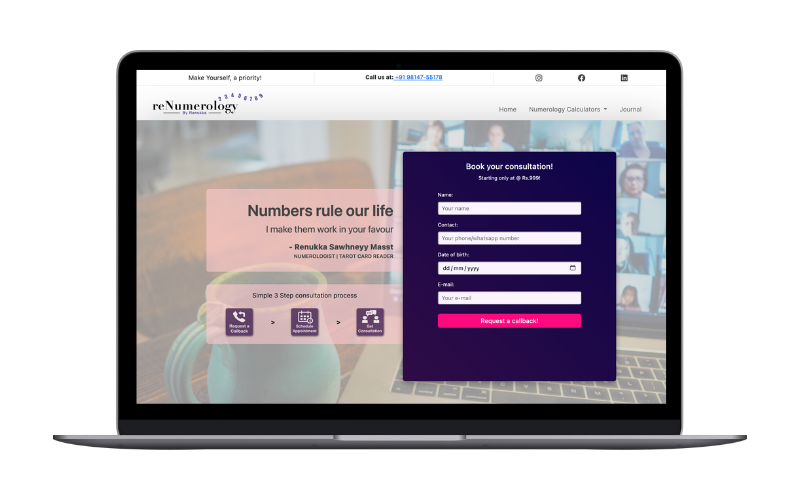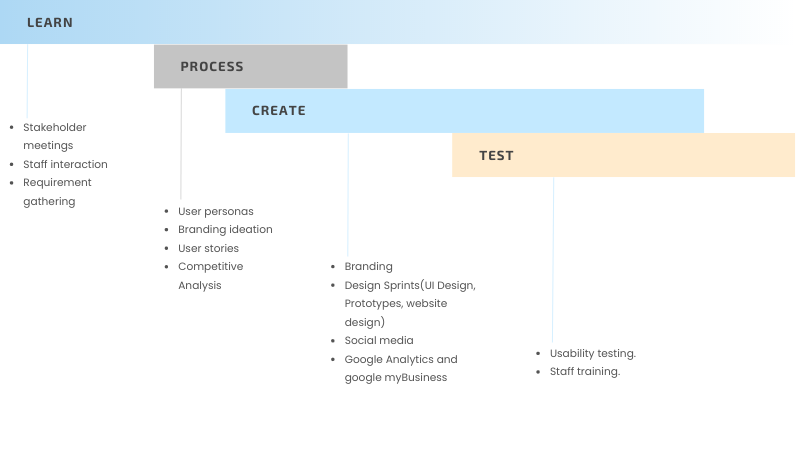
Digital transformation for a professional numerologist.
ROLE
Web developer, UX Designer, Digital Marketing.
WEBSITE
OVERVIEW
THE PROBLEM
“Hey Apaar! I am looking to broaden my client base, drive more bookings, and provide valuable numerology insights to my clients.”
Renukka is a professional numerologist who is providing professional numerology services since the last 22 years. Her business is majorly based offline and through word of mouth. Despite their expertise and reputation, the numerologist faced challenges in effectively showcasing their services online, connecting with potential clients, and providing accessible resources online, related to numerology.
THE SOLUTION
“We need to find innovative ways to increase brand awareness, engage potential clients, and ultimately convert these engagements into leads. This calls for a detailed plan to revamp the website's user experience, create and distribute compelling content, implement a streamlined booking system, and establish a strong and cohesive online presence across various platforms.”
THE OUTCOME

Optimised strategy that enhanced local search visibility, while enriched user experiences and provided a seamless booking processes. Resulting in an increase in Google My Business inquiries, website engagement, call-to-booking conversions, along with deeper engagement and business growth.
How did we acheive this?
Let's dig in.

Lets break this down further.
Stakeholder Meetings: Survey current processes and gather insights
Before conducting the user research, I scheduled a meeting with the numerologist with an aim to gather insights about the requirements for the project and evaluate the current branding, marketing and online scenario of the business. The outcomes were as follows:
- Website review: A simple low-design landing page website with information about the services offered and contact details. There was a lack of engaging content and a strategy to convert visitors into clients.
- Online Presence review: The numerologist was lacking online presence across business development and social media platforms.
After surveying the current processes and gathering insights, i assembled a report with key insights and recommendations which i would like to address in order to achieve the goal.

User research & Competitive analysis: Defining the target audienc.
To gain insights, I interviewed a few clients of the numerologist in order to gain insights about their expectations, experience and challenges in looking for numerology services and accessing information regarding the field of numerology online.

User Personas
These interviews helped identify common pain points and informed the creation of user personas, which represented different segments of the target audience. Based on the research findings and user personas, the UX design team used Figma, a collaborative design tool, for wireframing and prototyping.



The user interviews and personas were kept at the center and informed our decisions while carrying out any kind of developments in the projects. Be it branding, user interface design, development or marketing. This allowed for the creation of user-friendly interfaces that addressed the identified pain points and catered to the specific needs of different user segments.

How did we overcome these pain points? Lets dig into that
Information architecture and content mapping: Defining the structure, features, navigation design and user flow of the website.
While creating navigation, labelling and structuring the content on the website, i used the “customer first approach” which was informed by the research phase and only included the things that the customers need to prevent cluttering of information on the website.

Based on the information acquired from the customers, the features that I identified to showcase on the website were:
- Services and expectations: To proactively provide information to the visitors who are looking for numerology services and provide information on what to expect out of a numerology consultation session.
- Appointment Booking System: A straightforward appointment booking system.
- Specialisation: To give information about what services does the numerologist specialise in.
- Reviews and testimonials: To build trust and confidence.
- Numerology Calculators: To provide the visitors with self accessible numerology information which could give them the surface level idea of their numbers so that they can identify weak areas and take steps/ consultation to make them strong.
- Blog: To provide numerology information online which can help in engaging the visitors and provide added value to their experience.
While creating navigation, labelling and structuring the content on the website, i used the “customer first approach” which was informed by the research phase and only included the things that the customers need to prevent cluttering of information on the website.

Design Sprints: Sprint planning, low-fidelity and high-fidelity prototypes

In the pursuit of excellence, we embraced the power of design sprints – a symphony of innovation, strategy, and meticulous planning. I proudly led the charge in orchestrating these sprints, ensuring each step resonated with purpose. The process might lack a visual spectacle, but its impact is monumental. It's the mix of boundless dedication, transforming abstract visions into tangible milestones.
wireframes
During the design process, careful attention was given to the website's information architecture, ensuring that content was logically organised and easy to navigate. Clear and intuitive user flows were created to guide visitors through the site, making it effortless for them to find information about tyre products, services, and contact details.
Furthermore, visual design elements such as typography, color scheme, and imagery were carefully selected to create a visually appealing and cohesive interface that aligned with the brand identity established during the branding phase. The resulting UX design provided a seamless and user-friendly experience for visitors to the website, enabling them to make informed decisions and easily engage with the numerologist.
Web Development: Front-End, Back-end and Final website
Responsiveness was a key consideration during the front-end development process. The website was designed and developed to adapt seamlessly to different devices and screen sizes, providing a consistent user experience across desktops, laptops, tablets, and mobile devices.

Front-end development focused on implementing the visual elements and interactivity of the website. The UX design provided the foundation for the front-end development, with careful attention given to translating the design into clean and well-structured HTML and CSS code. This ensured that the website's layout, typography, and color scheme were optimized for both aesthetics and user experience.
Back-end development involved the implementation of the WordPress CMS to facilitate content management and website maintenance. This allowed the numerologist to easily update and add content, such as services information, blog posts, numerology calculators and self numerology insights, without requiring technical expertise. The WordPress CMS also provided robust security measures to protect customer data and ensure the integrity of the website.
The Final look
